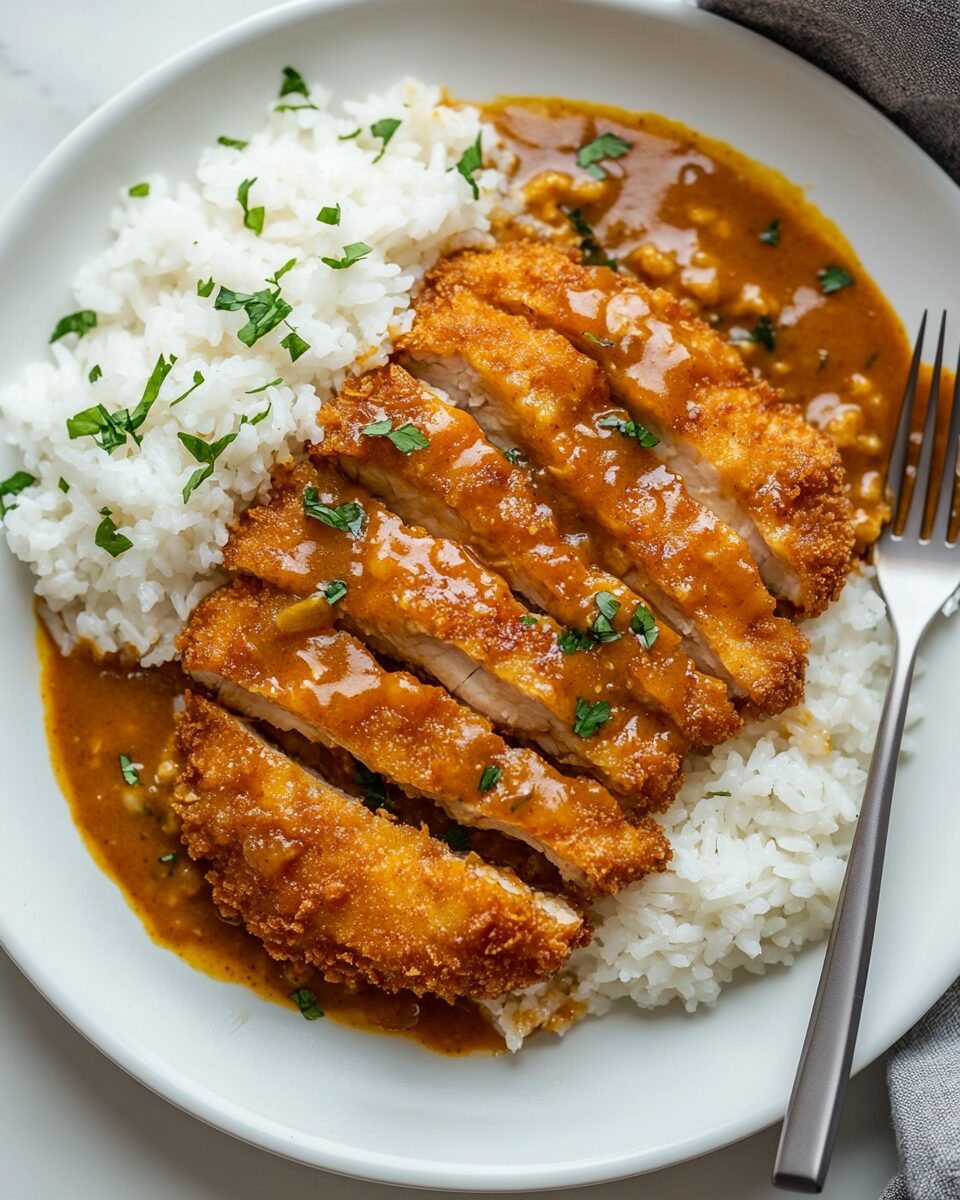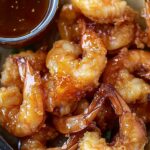This Japanese Chicken Katsu Curry combines crispy, tender chicken with a rich and savory curry sauce, making it the ultimate comfort food for weeknights. Using Japanese curry mix and a few ingredients, this quick and easy recipe delivers a satisfying meal for any time of the day.
Full Recipe:
Ingredients
Japanese Curry Sauce:
- 1/2 box Japanese curry mix
- 1 onion, diced
- 1 potato, diced
- 1/2 carrot, diced
Chicken Katsu:
- 2 large chicken breasts
- Salt, pepper, and garlic powder (to taste)
- 3 tbsp flour (or more if needed)
- 1 large egg, beaten
- 1 cup panko breadcrumbs
To Serve:
- 2 servings of cooked white rice
- Parsley for garnish
Directions
- Prepare the Curry Sauce:
Follow the instructions on the package to prepare the Japanese curry sauce. - Prepare the Chicken Katsu:
- Pound chicken breasts to an even thickness (~1/2 inch), then season both sides with salt, pepper, and garlic powder.
- Place flour, beaten egg, and panko breadcrumbs in three separate shallow dishes. Coat each chicken piece with flour, egg, and breadcrumbs in this order, ensuring even coverage and shaking off excess. Set aside for about 10 minutes.
- Heat about 2 inches of oil in a skillet or deep fryer over medium heat until it reaches 350°F. Fry each piece of chicken for 3–4 minutes per side, or until golden brown.
- Final Assembly:
Slice the cooked chicken katsu into bite-sized pieces. Serve over a bed of rice and top with the curry sauce. Garnish with parsley and enjoy!
Nutritional Breakdown (Per Serving)
- Calories: 448 kcal
- Protein: ~31g
- Chicken breast (1 large piece per serving) is a lean protein source.
- Carbohydrates: ~45g
- Japanese curry mix (~15g carbs per serving).
- White rice (1 serving, ~30g carbs).
- Vegetables (onion, potato, and carrot contribute ~5g carbs).
- Fat: ~12g
- Frying oil absorbed (~8g).
- Panko breadcrumbs (~2g).
- Egg (~2g).
- Fiber: ~2.5g
- Vegetables (potato, carrot, and onion).
- Sugars: ~4g
- From the curry mix and vegetables.
- Sodium: ~600mg
- Mainly from the curry mix and seasoning.
- Cholesterol: ~125mg
- Egg and chicken contribute to this value.
This breakdown can vary based on the specific brands of ingredients used, portion sizes, and cooking methods (e.g., oil absorption during frying). Let me know if you’d like help adjusting for specific ingredients!
The History Behind Katsu Curry
Katsu curry has its roots in Yoshoku cuisine, a style of Japanese cooking inspired by Western dishes. “Katsu” refers to breaded and fried cutlets, typically made from pork or chicken, and “curry” was introduced to Japan by the British in the late 19th century. The Japanese adapted curry to their palate by creating their own version of curry roux, which is less spicy and more mellow compared to Indian curries. Over time, pairing katsu with curry sauce and serving it over rice became a staple comfort food, popular in homes, restaurants, and even school lunches across Japan.
Why Japanese Curry Stands Out
Japanese curry differs significantly from other types of curry around the world. It is characterized by its mild heat, rich umami, and slightly sweet undertones. Unlike traditional Indian or Thai curries, Japanese curry is thickened with roux, giving it a hearty, gravy-like texture that clings beautifully to the crispy katsu and steamed rice. The addition of vegetables such as potatoes, carrots, and onions contributes to its depth of flavor, making it a balanced and nutritious option for any meal.
The Secret to Perfect Chicken Katsu
The key to achieving the perfect chicken katsu lies in the technique and ingredients. The chicken is pounded to an even thickness to ensure even cooking and then coated in a three-step breading process: flour, beaten egg, and panko breadcrumbs. Panko, a Japanese breadcrumb, is the star ingredient, known for its light and airy texture that creates an unparalleled crunch when fried. Frying the chicken at the right temperature, typically around 350°F, ensures a golden-brown crust without overcooking the meat.
Allowing the breaded chicken to rest before frying is another essential step. This helps the coating adhere firmly to the chicken, preventing it from falling off during frying. The result is a beautifully crisp exterior that contrasts wonderfully with the tender, juicy chicken inside.
Customizing the Curry Sauce
The beauty of Japanese curry sauce is its adaptability. While the classic combination of potatoes, carrots, and onions is traditional, you can easily customize the sauce with additional ingredients like bell peppers, mushrooms, or even chunks of apple for a hint of natural sweetness. For those who enjoy a bit more heat, adding a touch of cayenne pepper or red chili flakes can elevate the spice level.
Using store-bought Japanese curry mix makes this dish accessible for cooks of all skill levels, but adventurous chefs can also prepare the roux from scratch. Homemade curry roux typically involves a mix of flour, butter, curry powder, and additional spices, allowing for complete control over the flavor profile.
Serving Suggestions
Chicken Katsu Curry is traditionally served with a bed of fluffy white rice, but there’s room for creativity. Swap out white rice for brown rice or quinoa for a healthier twist. Some prefer to serve the dish with a side of shredded cabbage dressed in a light vinaigrette, which adds a refreshing crunch and balances the richness of the curry.
For a complete Japanese-inspired meal, consider serving miso soup, pickled vegetables (tsukemono), or a small green salad alongside the curry. These side dishes complement the flavors of the katsu curry and provide additional texture and variety.
The Nutritional Profile
This dish strikes a balance between indulgence and nutrition. The chicken provides a high-quality protein source, while the vegetables contribute essential vitamins, minerals, and dietary fiber. Although frying adds some fat and calories, the use of panko breadcrumbs ensures a lighter and less greasy result compared to traditional breadcrumbs.
The addition of white rice makes this a carbohydrate-rich dish, providing a source of energy, but this can be modified with healthier grain options. The dish also offers a good balance of fats, primarily from the frying oil and the egg used in breading. While sodium content is mainly influenced by the curry roux, choosing low-sodium varieties or making your own can help reduce this.
Tips for Reheating and Storing Leftovers
One of the best things about Chicken Katsu Curry is how well it reheats, making it an excellent meal prep option. For the best results, store the chicken katsu and curry sauce separately. Reheat the curry sauce in a saucepan over medium heat, stirring occasionally, and reheat the chicken in an oven or air fryer to maintain its crispiness. Avoid microwaving the chicken, as it may lose its crunch.
Leftovers can last up to three days in the refrigerator or up to one month in the freezer if properly stored. Be sure to use airtight containers to prevent moisture loss and freezer burn.
Cultural Significance and Popularity
Chicken Katsu Curry has become a beloved dish not just in Japan but worldwide. It is frequently featured on the menus of Japanese restaurants and casual dining chains. Its global appeal lies in its comforting, universal flavors and ease of preparation. Many home cooks turn to this dish as a gateway into Japanese cuisine because it incorporates familiar elements while introducing unique Japanese flavors.
In Japan, katsu curry is often enjoyed during celebrations or as a hearty pick-me-up meal. The dish is also associated with good luck, particularly when consumed before important events like exams or sports matches, as “katsu” is a homophone for the Japanese word meaning “to win.”
Conclusion
Japanese Chicken Katsu Curry is more than just a meal—it’s an experience. Combining the crispy perfection of chicken katsu with the rich, velvety curry sauce creates a dish that’s both satisfying and soul-warming. Its simplicity and adaptability make it accessible to cooks of all levels, while its depth of flavor ensures it remains a favorite for seasoned food enthusiasts. Whether you’re exploring Japanese cuisine for the first time or seeking a comforting classic, this dish delivers every time. From its rich history to its versatile nature, Chicken Katsu Curry is a testament to the creativity and universal appeal of Japanese food. Give it a try, and it just might become a staple in your own kitchen!






